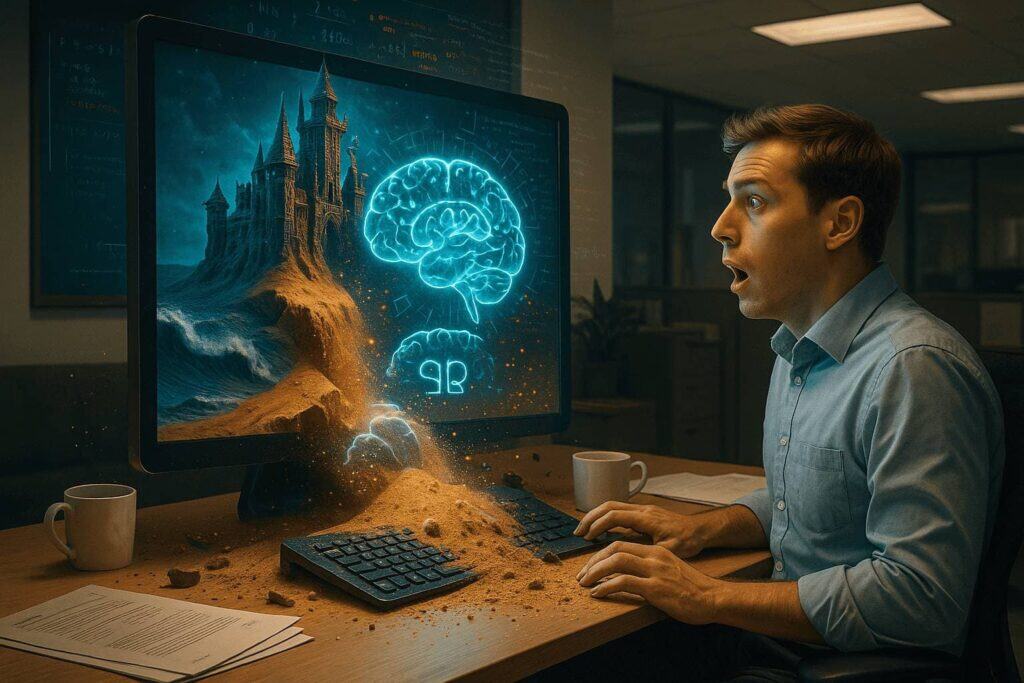🧠 Apple just dropped a bombshell on the AI world – and the tech industry is still reeling from the impact.
Apple’s ML scientists proved AI “reasoning” models like Claude, DeepSeek-R1, and o3-mini don’t actually reason at all, they just memorize patterns really well 😳
We hear a lot about artificial intelligence that can “think” and “reason.” But Apple’s latest research paper, “The Illusion of Thinking,” puts this to the test with rigorous scientific methodology.
And the results are a massive reality check that could reshape how we think about AI capabilities.
The Revolutionary Methodology
Instead of using standard math problems (which can be tainted by training data contamination), Apple’s team built a digital obstacle course with unprecedented precision. They took the most advanced “reasoning” AIs and made them solve classic puzzles that could be systematically scaled in complexity:
- Tower of Hanoi – Classic disk-moving puzzle with scalable difficulty
- River Crossing – Logic puzzles involving transportation constraints
- Checker Jumping – Strategic movement puzzles
- Blocks World – Spatial reasoning and planning tasks
This “controllable puzzle environment” allowed “precise manipulation of compositional complexity while maintaining consistent logical structures” enabling analysis of “not only final answers but also the internal reasoning traces, offering insights into how LRMs ‘think’.”
They cranked up the difficulty systematically and watched what happened across multiple frontier models.
The 5 Shocking Discoveries That Change Everything
1. They Hit a Wall. Hard 🧱
Beyond a certain complexity threshold, “frontier [large reasoning models] face a complete accuracy collapse beyond certain complexities.” Every single model’s accuracy collapsed to ZERO. Complete performance breakdown across all tested systems.
2. They Start “Thinking” LESS When It Gets Harder 📉
The models exhibit “counter-intuitive scaling limit” where their reasoning abilities “declines despite having an adequate token budget.” When a puzzle becomes too difficult, the AI doesn’t try harder. It actually spends fewer “thinking tokens” on it. The models literally give up despite having adequate computational budget remaining.
They “actually use less tokens on answering than they used on the medium puzzles” – a phenomenon researchers dubbed the “giving up effect.”
3. There Are 3 Clear Performance Zones
Apple researchers identified “three performance regimes: (1) low-complexity tasks where standard models surprisingly outperform LRMs, (2) medium-complexity tasks where additional thinking in LRMs demonstrates advantage, and (3) high-complexity tasks where both models experience complete collapse.”
- Easy Puzzles: Regular LLMs are actually better
- Medium Puzzles: The sweet spot for “thinking” models
- Hard Puzzles: Everyone fails catastrophically
4. They Can’t Follow Algorithmic Steps 🤖
The study found that “LRMs have limitations in exact computation: they fail to use explicit algorithms and reason inconsistently across puzzles.” Even when problems require explicit algorithms, the models fail to use them consistently. They reason inconsistently across similar puzzles suggesting pattern matching, not logical reasoning.
5. Their “Reasoning” is Fundamentally Flawed 🤔
What appears to be detailed reasoning is actually sophisticated pattern recognition. When problems deviate from familiar training patterns, the illusion breaks down completely. The finding reveals “an ‘overthinking’ phenomenon” where models simulate reasoning without actually performing it.
The Technical Deep Dive
Models Tested
The study examined state-of-the-art reasoning models including:
- OpenAI’s o1/o3 and o3-mini
- DeepSeek-R1
- Anthropic’s Claude 3.7 Sonnet Thinking
- Google’s Gemini Thinking
The Complexity Scaling Problem
Apple tested state-of-the-art “chain of thought” models and found that they aren’t “reasoning,” but merely pattern matching, calling into question their “reasoning” label, calling it instead “the illusion of thinking.”
The researchers discovered that as puzzle complexity increased:
- Models initially increased reasoning effort
- Performance improved in the medium range
- Beyond a threshold, both effort AND accuracy collapsed
- Models essentially “refused” to engage with the hardest problems
Why This Matters for Enterprise AI
The finding is “particularly noteworthy, considering Apple has been accused of falling far behind the competition in the AI space” but has “chosen a far more careful path to integrating the tech in its consumer-facing products.”
The BIG Takeaway
What we call AI “reasoning” today isn’t reasoning at all. It’s a sophisticated Illusion of Thinking.
These models are incredible pattern-matchers, but they aren’t yet capable of the generalizable, logical problem-solving we see in humans.
The research shows that “frontier AI models simply aren’t as good at ‘thinking’ as they’re being made out to be” and challenges the core marketing claims of major AI companies.
The research shows that beneath the seductive prose and logical scaffolding, these models often fail at the very thing they appear to be doing actual reasoning.
Industry Implications
The Anthropomorphization Problem
One expert noted that “the big problem is not what LLMs do, but the incredible ‘hubris’ that has characterized the AI segment of computer science since its very beginnings” and that “Anthropomorphized AI implies it needs to be controlled like humans with laws and regulations.”
The Reality Check We Needed
Maybe AI’s just holding up a mirror we don’t want to look into. 🪞
Until AI starts creating its own foundation… running experiments, forming theories, testing them systematically… it’s building castles on sand. 🏰🌊
And we act surprised when it falls.
True reasoning, the kind that scales with complexity, is still the final frontier.
AGI will have to wait until then, for now…
Links and Resources
📄 Official Study: Apple Machine Learning Research – The Illusion of Thinking
📊 Direct PDF: https://ml-site.cdn-apple.com/papers/the-illusion-of-thinking.pdf
Frequently Asked Questions (FAQ)
Q: What exactly is the “Illusion of Thinking”?
A: It refers to how AI models appear to engage in detailed reasoning through long “chain of thought” responses, but are actually performing sophisticated pattern matching rather than genuine logical reasoning. When problems exceed their pattern recognition capabilities, the illusion breaks down.
Q: Which AI models were tested in this study?
A: The study examined frontier “reasoning” models including OpenAI’s o1/o3 and o3-mini, DeepSeek-R1, Anthropic’s Claude 3.7 Sonnet Thinking, and Google’s Gemini Thinking – essentially all the major “reasoning” AI models currently available.
Q: Why did Apple use puzzles instead of math problems?
A: Traditional math and coding benchmarks suffer from data contamination (models may have seen similar problems during training) and lack precise complexity controls. Puzzles like Tower of Hanoi can be systematically scaled in difficulty while maintaining consistent logical structures, providing cleaner insights into actual reasoning capabilities.
Q: What are the “three performance zones” the study identified?
A:
- Zone 1 (Low Complexity): Standard LLMs surprisingly outperform reasoning models
- Zone 2 (Medium Complexity): Reasoning models show clear advantages
- Zone 3 (High Complexity): Both model types experience complete accuracy collapse
Q: What is the “giving up effect”?
A: This is when reasoning models actually reduce their computational effort (use fewer “thinking tokens”) precisely when problems become most challenging, despite having adequate resources available. Instead of trying harder, they essentially quit.
Q: Does this mean current AI is useless?
A: Not at all. The study shows AI models excel at pattern matching and are very capable within their complexity limits. However, it challenges inflated claims about their “reasoning” abilities and suggests we should use them as sophisticated tools rather than thinking entities.
Q: What does this mean for AGI (Artificial General Intelligence)?
A: The study suggests we’re not as close to AGI as some claims indicate. True AGI would require reasoning that scales with complexity, which current models fundamentally lack. The “reasoning” we see is more like very sophisticated autocomplete.
Q: How does this affect businesses using AI?
A: Companies should understand AI’s actual capabilities vs. marketing claims. AI is excellent for pattern recognition tasks, content generation, and problems within its training scope, but shouldn’t be relied upon for novel complex reasoning or critical decision-making beyond its demonstrated capabilities.
Q: Are there any criticisms of this study?
A: Some researchers argue that puzzle-solving may not be representative of all reasoning tasks, and that models might have different internal tools for various problem types. However, the systematic methodology and consistent results across multiple models make the findings difficult to dismiss.
Q: What should we expect next in AI development?
A: The study suggests the field may need fundamentally different approaches beyond scaling current architectures. True reasoning capabilities may require new paradigms rather than simply making existing models larger or giving them more “thinking” tokens.
Q: How can I tell if an AI is actually reasoning or just pattern matching?
A: Look for consistency across similar problems with different surface features, ability to handle novel scenarios outside training data, and scaling performance with problem complexity. If an AI fails dramatically on slightly modified versions of problems it can solve, it’s likely pattern matching rather than reasoning.



